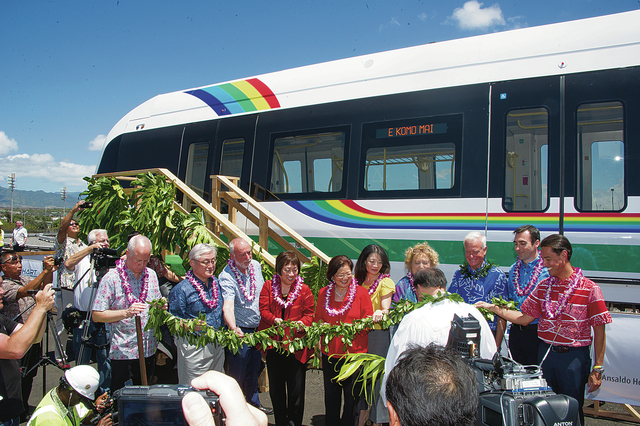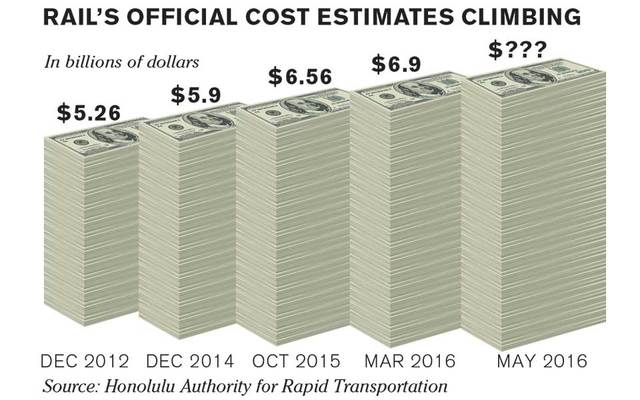The official cost estimates for Honolulu’s rail transit system have grown by nearly $350 million in recent months, raising more concerns that the city’s new five-year rail tax extension won’t be enough to finish the project.
A budget update marked confidential and prepared by the Honolulu Authority for Rapid Transportation in March shows that the rail agency’s estimates increased $348 million between that month and October, which is the last time the agency briefed the public with an official budget update.
The new local estimates, which are mostly based on the cost increases to build rail’s second 10 miles and final 12 stations heading into town, now put the project’s total price tag at some $6.9 billion.
The total costs have grown at least $1.64 billion since December 2014, based on HART estimates.
That price tag is poised to grow, however.
Rail’s federal partners say they believe the total cost is “significantly higher” than HART’s March estimates, although they haven’t finalized their own estimates yet, according to HART board Chairwoman Colleen Hanabusa.
Hanabusa provided HART’s March budget update to the Honolulu Star-Advertiser after a board meeting Thursday in which a project consultant repeatedly referred to a higher project cost than the rail agency had previously reported. Hanabusa said she wants to keep the public and local leaders in the loop on cost estimates as much as possible.
“I don’t want (the City) Council getting more huhu with us — they’re already huhu with us — and then saying, ‘You lied to us again,’” she said. “I don’t want that to happen. Be sure they know.”
HART executive Director Dan Grabauskas said the rail agency prepared the budget update internally in March as part of a “risk-refresh” exercise with the Federal Transit Administration — a necessary step for HART as it updates its outdated financial plan. The details eventually would have been presented to the public once the risk-refresh process was completed, he said.
“We try not to get out ahead” of the project’s federal partners, Grabauskas said Thursday.
As for the increased estimates, “we are very concerned based on the fact that prices in the market continue to climb unabated,” Grabauskas said. “And we have the utility issues … and schedule challenges.”
He stressed that the budget estimates “weren’t solidified in any way” and that they represented “an evolution based on continuing analysis and new data.”
HART won’t have a firm idea of rail’s true cost until it awards the final two contracts to complete the guideway and stations and it resolves major utility line issues, he added. (Jacobs Engineering, which serves as the project’s independent oversight firm, has dubbed the utility clearances rail’s most significant risk.)
Rail officials estimate the five-year general excise tax surcharge extension approved by the Honolulu City Council in January will generate more than $1.5 billion for the project. However, Hanabusa on Thursday echoed a growing chorus of concerns among the island’s leaders that it won’t be enough to finish the full 20-mile line to Ala Moana Center — even though rail leaders said last year that the tax extension would likely be sufficient.
Last month Honolulu Mayor Kirk Caldwell proposed using some of the state’s controversial 10 percent skim of rail’s general excise tax surcharge to fund actual rail construction if the project needs more money. On Thursday Hanabusa said that wouldn’t be sufficient if rail does eventually need more cash.
“It’s not enough,” Hanabusa said, adding that it was doubtful rail officials could go back to state lawmakers and ask them to authorize another tax extension.
“As good friends as my friends are at the Legislature, many of them have told me straight, ‘Just because we’re your friend, don’t think you can come back and ask us for money.’ They’re not going to do it, and I doubt the Council will raise the property tax,” Hanabusa said Thursday. “I will tell you, I don’t know what the options are, but we’re going to have to figure out what to do.”
The solution will involve discussions with rail’s FTA partners, she added.
The federal agency has a $1.55 billion funding agreement to help build rail. In November the FTA informed city officials that it would withhold remaining funds until HART provided an updated financial plan “with a commitment of all the local funds needed” to finish the project.
Rail officials estimate that financial plan should be done by the end of this year, and they report that their agency still has about $300 million in federal funds to draw down. But it remains to be seen what rail’s federal partners will do about the withheld dollars — which now total $500 million — if the recent tax extension proves to be too little.
Key leaders from the FTA and Jacobs Engineering, the firm that the federal agency hired to oversee the project, are on Oahu this week for a quarterly meeting to discuss rail.
HART’s March numbers assume it will cost an additional $309.7 million on top of what it estimated in October to build rail’s second half heading into town.
The estimate also assumes it will cost an additional $128 million to build the project’s Pearl Highlands parking garage. However, rail officials still hope to drastically reduce that facility’s costs by partnering with private firms to build it. Grabauskas said HART will know in about a week whether any firms are interested.
“These are the cards we were dealt,” Hanabusa said Thursday. “How do we proceed?”
CPP Projection Cost Estimate by Honolulu Star-Advertiser




